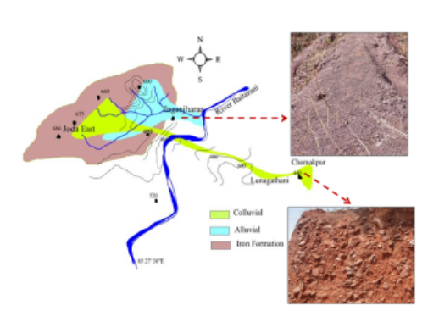


Indian Journal of Science and Technology
Year: 2023, Volume: 16, Issue: 24, Pages: 1823-1832
Original Article
Amiyaranjan Parida1*, Devananda Beura2
1Research Scholar, P.G. Department of Geology, Utkal University, Bhubaneswar, Odisha, India
2Associate Professor, P.G. Department of Geology, Utkal University, Bhubaneswar, Odisha, India
*Corresponding Author
Email: [email protected]
Received Date:21 March 2023, Accepted Date:02 June 2023, Published Date:24 June 2023
Objectives: North Odisha Iron Ore Craton (NOIOC) is a distinguished place for iron formation with Banded Iron Formation (BIF) as a common and abundant litho type. In few localities in Bonai-Keonjhar belt (BK belt) Channel Iron Deposits (CID) specifically detrital type of iron deposits occur along with BIF. Chamakpur-Inganjharan sector of BK belt located on both sides of bank of the River Baitarani is occupied by Detrital Iron Deposits (DID) with varying spatial horizon. A comprehensive study had been carried out on morphology and mineralogical characteristics of DID in the specified field area to locate new occurrences of iron ore. Methods: The morphology part of the study is primarily focused on field observations revealing depositional configuration with respect to size, sorting and orientation of clasts. Mineralogical studies have been carried out by using optical microscope with supported by Xray Diffraction (XRD) instrumental technique. The bulk chemical analysis was carried out by employing X-ray Fluorescence (XRF) instrument. Findings: The DID mostly occurs as isolated bodies with limited extensions comprising predominantly of cobbles and pebbles of hematite with varying amounts of shale, BIF & quartz clasts. Mineralogical study reveals that DID of the study area mainly consist of hematite, goethite, quartz and clay. Hematite, goethite, silica and clay are common matrix that bind the clasts in DID. Novelty: DID occur as a type of iron formation next to Banded Iron Formation with regards to abundancy, which has not yet been focused for prospecting. Not much geological work has been done in the area to attain the commercial production of DID, even though they are available in suitable grades. So this paper discusses about the lithological and mineralogical characteristics of DID, which will help in mining of detrital Fe-ores to maintain the sustainable mineral development in a fast depleting BIF hosted Fe-ore scenario. We also discussed the possible mode of deposition of DID in form of alluvium and colluvium that have been supplied from bedded type of Fe deposits. It is evident from the studies that dominated by hematite fragments, DID can be the future source of iron production.
Keywords: Detrital Iron Deposit (DID); North Odisha Iron Ore Craton (NOIOC); Morphology; Mineralogy; BK belt
© 2023 Parida & Beura. This is an open-access article distributed under the terms of the Creative Commons Attribution License, which permits unrestricted use, distribution, and reproduction in any medium, provided the original author and source are credited. Published By Indian Society for Education and Environment (iSee)
Subscribe now for latest articles and news.